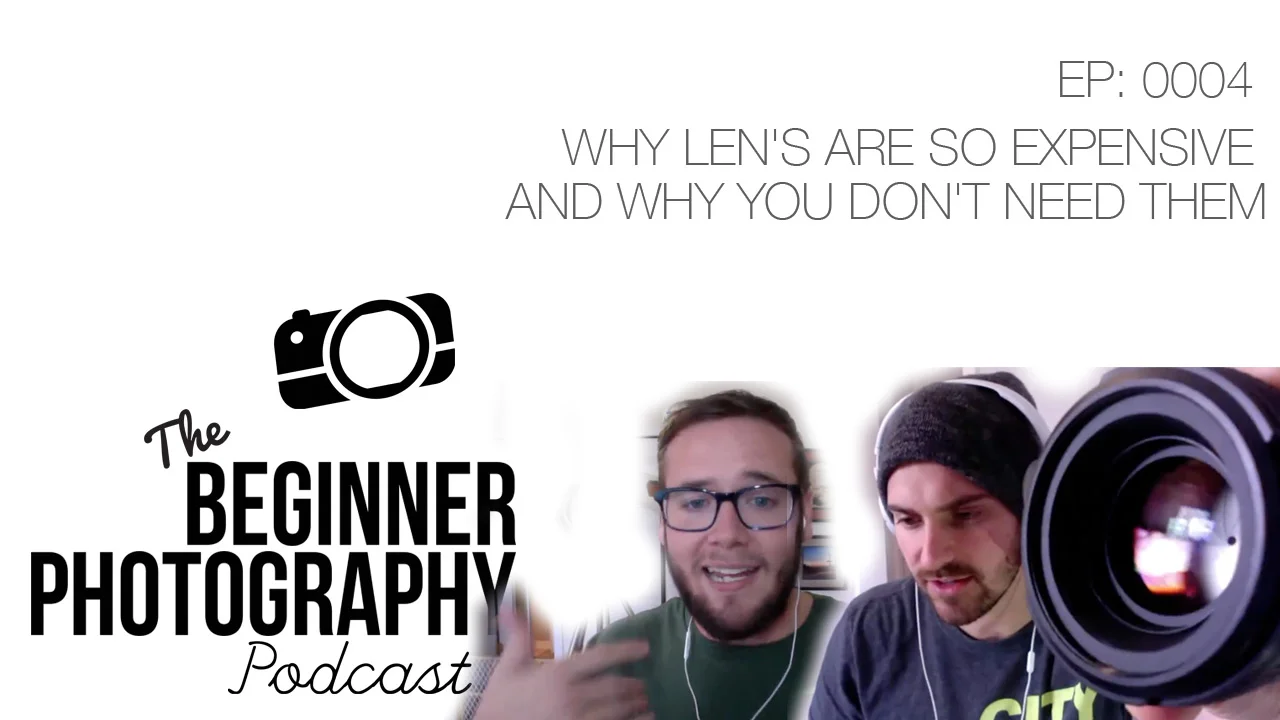EP: 004 Why Lenses are so Expensive and why you DON'T need them
In this episode we talk all about camera len's. From wide angle, standard, and telephoto len's. We talk about what makes them so expensive. The features you should look for in a new lens and what isn't important. Really focusing on what you WANT to shoot will help guide you in the right direction.
The Big Ideas with Time Stamps
00:05:21 Love what you do.
00:06:37 Passion is key to photography.
00:18:45 Invest in lenses, not cameras.
00:19:30 The importance of quality glass.
00:29:06 Invest in lensed with image stabilization.
00:33:14 Image stabilization is a lifesaver.
00:40:25 Shoot primes for better quality.
00:53:37 Compression affects connection.
00:55:52 Save money on lenses.
01:02:17 Shoot more to improve.
In this episode you'll learn:
Why you need to shoot personal work
Why photography is an adventure
Why there is such a huge difference in price for 50mm lens
The difference in quality between glass and plastic lenses
Why the limitations of plastic lenses
Why I would recommend the Canon 50mm 1.8 over the 50mm 1.4
Why lenses are more important than your camera body
Why you should spend less on your camera and more on your lens
What Chromatic Aberrations are
And why they are so important to know about
What the difference be Vibration Reduction and Image Stabilization is
What Image Stabilization is
How it works
When NOT to use it
What a Prime lens is
Why Prime lenes are less versatile but generally more expensive
Why some photographer would rather shoot with Prime lenses rather than Zooms
How a lens can make you lazy
When a zoom lens is better than a prime lens
Why you shouldn't just crop your photos closer
What compression is when it comes to focal lengths
When you should use a 16mm vs a 50mm vs a 200mm lens
The differance between 135mm and 17mm
How to get a different connection with your images
135mm Lens
17mm lens
The red line at the top of the tablet is caused by chromatic aberration
Gear we talked about in this episode.
If you have any questions Feel free to email us today at
BeginnerPhotographyPodcast@gmail.com
Connect with us on Facebook!
www.facebook.com/beginnerphotographypodcast/
Do what you love.
Doing what you love is a concept that many people talk about, but few people actually put into practice. It is easy to get caught up in the hustle and bustle of life and forget why you started doing something in the first place. This is especially true for those who are in a creative field, such as photography.
In the Beginner Photography Podcast, Raymond and Calum discuss the importance of doing something that you love. They talk about their weekends and how they both took time off to be in the moment instead of taking photos. Raymond talks about how he brought his camera to his in-laws' family gathering, but decided against taking any photos because it was more important to be in the moment. Calum talks about his new camera, a T750, and how he is itching to use it, but is also taking some time to decompress after a long wedding season.
Both Raymond and Calum emphasize the importance of taking time off to recharge and reflect on your work. It is important to remember why you fell in love with photography in the first place and to take breaks from it when needed. Doing what you love is not only about taking photos, but also about taking time for yourself.
Taking the time to do what you love is essential for both your physical and mental health. Doing something that you love can help you to stay motivated and focused on your goals. It can also help to reduce stress and anxiety and can even help to improve your overall wellbeing.
Doing what you love is a reminder that life is about more than just work. It is about taking time to enjoy the small moments, to be in the moment, and to appreciate the beauty of life. It is about taking time to do something that you love and that brings you joy.
Start with a Nifty 50.
For photographers, this often means taking out their camera and exploring the world around them. Whether it is a professional assignment or just a casual stroll, it is important to take time to appreciate the art of photography.
For those just starting out in photography, the best way to get started is with a Nifty 50. A Nifty 50 is a 50mm lens that is made of plastic and is relatively inexpensive. It is the perfect lens for those just starting out in photography as it is easy to use and provides great quality images.
The Nifty 50 is also a great lens for those looking to capture moments in their daily lives. When I first started out in photography, I used a Nifty 50 to capture moments of my friends hanging out or grabbing a beer. The lens allowed me to capture the moment without having to worry about the technical aspects of photography. It was just about capturing the moment and enjoying it.
The Nifty 50 is also a great lens for those looking to explore different areas. I recently took a walk with a friend and used my Nifty 50 to capture some of the beautiful scenery. It was a great way to explore the area without worrying about the technical aspects of photography.
The Nifty 50 is also a great lens for those looking to explore different types of photography. It is a great way to experiment with different types of photography such as portrait, landscape, and street photography. It is also a great way to learn the basics of photography such as composition and lighting.
Overall, the Nifty 50 is a great lens for those just starting out in photography. It is an inexpensive way to get started and it allows you to explore different types of photography. It is also a great way to capture moments in your daily life and to explore different areas. So if you are looking to get started in photography, the Nifty 50 is a great place to start.
Invest in lenses, not cameras.
However, if you are looking to take your photography to the next level, investing in a higher quality lens is a smart move. While it may be more expensive, it will pay off in the long run. Investing in a higher quality lens means that you will have a lens that will last you through multiple camera bodies. The quality of glass used in lenses is much higher than the plastic used in standard kit lenses. This means that you will get sharper images with less distortion and less chromatic aberration. Additionally, lenses with a larger aperture will allow more light into the lens, resulting in better image quality.
When it comes to investing in a lens, it is important to look at the numbers. For example, when you see something like 50 1.4, this means that it is a 50mm lens with a maximum aperture of F1.4. Similarly, if you see something like 70-200mm F2.8, this means that it is a 70-200mm zoom lens with a maximum aperture of F2.8.
Overall, investing in a higher quality lens is a smart move for those who want to take their photography to the next level. The quality of glass used in lenses will last you through multiple camera bodies, and the larger aperture will allow more light into the lens, resulting in better image quality. Additionally, it is important to look at the numbers when investing in a lens, as they will help you determine the maximum aperture and focal length of the lens. Investing in a higher quality lens is a great way to ensure that you get the best image quality possible.
Invest in quality glass.
When it comes to investing in quality glass, there are a few things to consider. First, it is important to look at the numbers. The numbers will help you determine the maximum aperture and focal length of the lens. Additionally, it is important to look at the glass used in the lens. Higher quality glass will last you through multiple camera bodies and will provide better image quality. It is also important to note that investing in a higher quality lens will be more expensive, but it is worth it for the improved image quality.
When it comes to the Canon and Nikon camera systems, there are some great lenses to choose from. For Canon users, the Nifty 50 is a great option and is only around $100. It is an f/1.8 lens, which is great for low light photography. Additionally, the f/1.4 lens is also a great option, but it is much more expensive at around $300. For Nikon users, the Nifty 50 is still a great option, but the f/1.4 lens is the flagship lens and is much more expensive at around $1500-$1700.
In conclusion, investing in a higher quality lens is a great way to ensure that you get the best image quality possible. It is important to look at the numbers when investing in a lens, as they will help you determine the maximum aperture and focal length of the lens. Additionally, it is important to look at the glass used in the lens, as higher quality glass will provide better image quality. For Canon and Nikon users, the Nifty 50 is a great option, and the f/1.4 lens is a great option as well, although it is much more expensive. Investing in quality glass is a smart move for those who want to take their photography to the next level.
Use image stabilization for low light.
When it comes to low light photography, image stabilization is a must. Image stabilization helps reduce the amount of shake that can occur when shooting in low light conditions. This is because the lens has a pocket of fluid with a smaller lens inside that can move around slightly to help soften out the image. This is especially beneficial for sports photography, as it can help reduce the amount of shake that can occur when shooting moving subjects. Additionally, it is great for low light photography, as it allows you to reduce the shutter speed to get more light into the sensor without risking a blurry image. Image stabilization is also great for longer lenses, as it helps reduce the amount of shake that can occur when shooting at longer focal lengths. Investing in an image stabilized lens is a great way to ensure that you get the best image quality possible in low light conditions.
Invest in image stabilization.
However, it is important to note that image stabilization can actually have a negative effect when shooting on a tripod. This is because the technology can actually cause the image to become softer instead of sharper. Therefore, if you are shooting astrophotography, it is important to turn off the image stabilization feature on your lens. Additionally, if you are shooting at very fast shutter speeds, image stabilization can also be detrimental, so it is important to turn it off in these cases as well.
Overall, investing in an image stabilized lens is a great way to ensure that you get the best image quality possible in low light conditions. However, it is important to keep in mind that image stabilization can have a negative effect in certain situations and should be turned off in these cases.
Use primes for better quality.
Primes are lenses that have a fixed focal length, meaning that they cannot zoom in or out. On the other hand, zoom lenses have variable focal lengths, allowing photographers to adjust the focal length of the lens without having to switch lenses. Primes offer a number of advantages over zoom lenses, such as improved image quality, better depth of field, and increased creativity.
When it comes to image quality, primes are superior to zooms. This is because primes have fewer glass elements, which reduces the amount of light that is lost and results in sharper images. Primes also have wider apertures, which allows for more light to enter the lens and create a more shallow depth of field. This can be especially useful for portrait photography, as it allows the photographer to blur the background and focus on the subject.
Primes also offer more creative control. By having a fixed focal length, the photographer is forced to move around and interact with their subject, rather than simply zooming in or out from a distance. This can lead to more interesting and unique compositions, as well as more intimate connections with the subject.
Ultimately, primes are the best choice for photographers who are looking for the highest image quality and creative control. While zoom lenses can be useful in certain situations, primes offer superior image quality and more creative control. If you are looking to take your photography to the next level, investing in a prime lens is a great way to do so.
Compression affects connection.
One of the most important aspects of prime lenses is their ability to create a sense of compression in an image. Compression is the effect of making a subject appear closer than it really is. This is achieved by using a longer focal length lens and a wide aperture. Compression is an important tool for creating a sense of connection between the viewer and the subject. It can make a subject appear more intimate and engaging, and it can draw the viewer into the image.
Compression can be used in a variety of ways to create a sense of connection between the viewer and the subject. It can be used to draw the viewer into a scene and make them feel as if they are a part of it. It can also be used to make a subject appear more intimate, as if they are right in front of the viewer. Compression can also be used to create a sense of depth in an image, making the background appear further away than it really is.
Compression can be used to create a sense of connection between the viewer and the subject in a variety of ways. It can be used to draw the viewer into a scene and make them feel as if they are a part of it. It can also be used to make a subject appear more intimate, as if they are right in front of the viewer. Compression can also be used to create a sense of depth in an image, making the background appear further away than it really is.
The use of compression in photography can create a powerful connection between the viewer and the subject. It can draw the viewer into a scene and make them feel as if they are a part of it. It can also make a subject appear more intimate and engaging, and it can create a sense of depth in an image. Compression is an important tool for creating a sense of connection between the viewer and the subject, and it can be used in a variety of ways to create powerful and engaging images.
Save money on lenses.
One way to save money on lenses is to buy a prime lens. Prime lenses are lenses that do not zoom and are typically more affordable than zoom lenses. Prime lenses are great for capturing detail and creating compression. They are also smaller and lighter than zoom lenses, making them easier to carry and use. Prime lenses also allow photographers to get closer to their subjects and have more control over the depth of field. This makes them perfect for portrait photography, where the photographer wants to capture the emotion and personality of their subject.
Another way to save money on lenses is to rent a lens. This is a great option for photographers who want to try out a new lens before committing to buying it. Camera lens rentals are often much cheaper than buying a lens outright. This allows photographers to test out a lens and make sure it is the right one for their needs before making a purchase.
Finally, photographers can save money on lenses by buying used lenses. Used lenses can often be found at a fraction of the cost of a new lens. This is a great option for photographers who want to save money but still get a quality lens. It is important to make sure the lens is in good condition before purchasing it, but this can be a great way to save money on lenses.
When it comes to buying lenses, there are a variety of ways to save money. Prime lenses are often more affordable than zoom lenses and can be used to create powerful and engaging images. Renting a lens is also a great way to save money, as it allows photographers to try out a lens before committing to buying it. Finally, buying used lenses can be a great way to save money while still getting a quality lens.
Take better photos today.
However, when it comes to taking better photos today, the quality of the lens is not the only factor. Understanding the basics of photography, such as composition, lighting, and shutter speed, is essential for creating beautiful and compelling images. Practicing these fundamentals will help photographers to become more confident and creative with their images. Additionally, having a good understanding of post-processing can help to turn good photos into great ones.
Taking the time to research and practice the basics of photography will pay off in the long run. With a little bit of effort, photographers can take better photos today and create stunning images that will last a lifetime.







